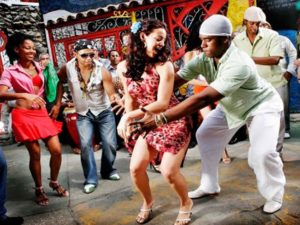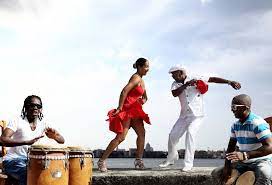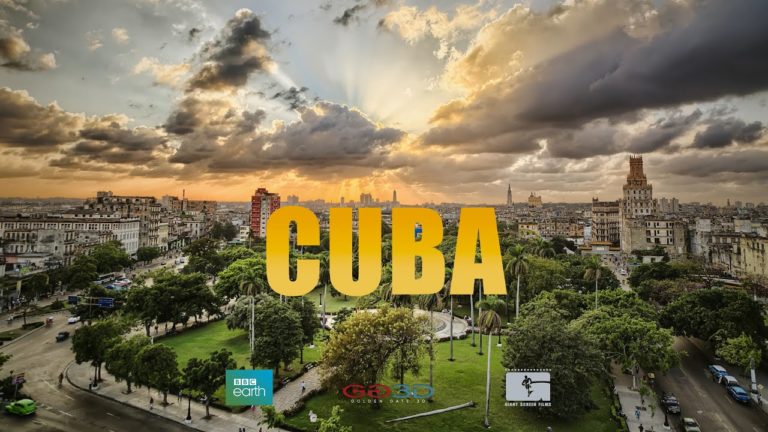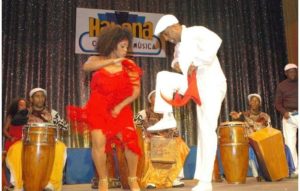LA RUMBA CUBANA…IT’S MUSIC, IT’S DANCE, IT’S IMPROVISATION. VIDEOS
To say “rumba” is to think of party, joy, fun. The Cuban Rumba reveals the waste of sensuality and flirtation of its dancers. A force in the drums, in the songs, and in the claps that rumbles the floor and shakes the body. It is a sensation that we islanders know very well.
There is no one who can resist the rumba. That is why the one who does not join the function, stops to admire it, with that little body movement of those who do not want the thing.
WHERE DOES THE RUMBA COME FROM?
The rumba is an explosive rhythm whose strength comes from the ancient African touches. From the yuka and makuta (Bantu dances) to the dance of the black curros and ñáñigos, they are African influences that are felt in this syncretic music.
And there is its origin, in the African culture, the one that painted much more color than the skins of its descendants and qualified what would later become our culinary, musical, and dance traditions.
The history of Cuban rumba dates back to colonial times, in the towns of Havana and Matanzas, where the black population made this Afro-Latino genre the protagonist of their parties.
For his amusements, the humble Negro created this rhythm, and dance, an endearing companion, could not be absent.
The rumbero accent is one more expression of the mixture of cultures that converge on the Island. In this case, the flamenco brought by the Spanish and the African rhythms brought by the slaves is combined.
But that was not the thing, the beat of the drums expanded until it merged with the guaracha, the conga … and it is that all Cuban music is influenced by the rumba, according to the percussionist Amandito Valdés.
DIFFERENT STYLES OF THE CUBAN RUMBA
Cuban rumba can be classified into three fundamental styles: the yambú, the columbia, and the guaguancó. Here we present them to you!
YAMBÚ
It is the oldest of all and comes from the urban suburbs in the province of Matanzas. It is danced in pairs, with slow and studied movements. The center of attention is the dancer, who shows off with discreet pelvic movements and flirts with the man all the time.
COLUMBIA
He comes from the rural areas of Matanzas but has a strong Congolese influence. It is a faster rhythm and is used for a single dancer – usually the man – to show his abilities.
Whoever interprets the dance interacts with the musician of the tumbadora and executes his steps upright, with arm and leg movements along with the typical hip undulations. Acrobatics and pantomimes are used between his steps. Flaunting his virility and prowess in dance, he often incorporates objects such as knives, machetes, or bottles on the floor.
GUAGUANCO
Born in the black neighborhoods of Havana, he is the most elaborate of the three, the most erotic, and the most danced. The man dances trying to conquer the woman, with a pelvic movement that simulates a sexual encounter. This step is known as “vaccinating.”
The woman, on her part, moves in a more subtle way, with sensuality and mischief. She tries to evade her partner and resists her attacks with a gesture where she covers her crotch with her skirt or with her hands. Although she rejects the man, the dancer continues the dance prompting him and provoking him to continue the flirting.
THAT’S THE CUBAN RUMBA
A feast of bodies, feelings, and a drum that has managed to become a faithful exponent of the most typical and characteristic of Cuban music, that is the rumba.
And the thing is that the rumba has «an I don’t know what that what I know». It envelops you, traps you, and at this point, all races succumb to it: the black, the mestizo, the white, the one from here and there.
Many have felt it and loved it … Nicolás Guillén from his sonorous verses «rumbera good, rumbera bad». Alejo Carpentier with his prose that permeates an autochthonous Cuban color. And, finally, Luis Carbonell, who sums up its essence in one sentence: “The rumba is Cuba”.
LA RUMBA CUBANA..ES MÚSICA, ES DANZA, ES IMPROVISACIÓN. VIDEOS.
Decir «rumba» es pensar en fiesta, alegría, diversión. La Rumba Cubana revela derroche de sensualidad y coqueteo de sus bailarines. Una fuerza en los tambores, en los cantos y en las palmadas que retumba el piso y estremece el cuerpo. Es una sensación que los isleños conocemos muy bien.
No hay quien se resista a la rumba. Por eso el que no se suma a la función, se detiene a admirarla, con ese pequeño movimiento corporal de quien no quiere la cosa.
DE DONDE VIENE LA RUMBA?
La rumba es un ritmo explosivo cuya fuerza viene de los antiguos toques africanos. Desde la yuka y makuta (danzas bantúes) hasta el baile de los negros curros y ñáñigos, son influencias africanas que se sienten en esta música sincrética.
Y ahí está su origen, en la cultura africana, esa que pintó de color mucho más que las pieles de sus descendientes y matizó lo que luego serían nuestras tradiciones culinarias, musicales y danzarias.
La historia de la rumba cubana se remonta a la época colonial, en pueblos de La Habana y Matanzas, donde la población negra hacía de este género afrolatino el protagonista de sus fiestas.
Para sus diversiones el negro humilde creó este ritmo, y la danza, compañera entrañable, no podía faltar.
El acento rumbero es una expresión más de la mezcla de culturas que convergen en la Isla. En este caso, se une el flamenco traído por los españoles y los ritmos africanos que trajeron los esclavos.
Pero ahí no quedó la cosa, el compás de los tambores se expandió hasta fundirse con la guaracha, la conga… y es que toda la música cubana está influenciada por la rumba, al decir del percursionista Amandito Valdés.
DIFERENTES ESTILOS DE LA RUMBA CUBANA
La rumba cubana se puede clasificar en tres estilos fundamentales: el yambú, la columbia, y el guaguancó. ¡Aquí te los presentamos!
YAMBÚ
Es el más antiguo de todos y proviene de los suburbios urbanos en la provincia de Matanzas. Se baila en pareja, con movimientos lentos y estudiados. El centro de atención es la bailarina, quien se luce con movimientos pélvicos discretos y coquetea al hombre todo el tiempo.
COLUMBIA
Proviene de las zonas rurales de Matanzas, pero tiene una fuerte influencia congolesa. Es un ritmo más acelerado y se utiliza para que un solo bailarín -normalmente el hombre- muestre sus capacidades.
Quien interpreta el baile interactúa con el músico de la tumbadora y ejecuta sus pasos erguido, con movimientos de brazos y piernas junto a las típicas ondulaciones de cadera. Entre sus pasos se emplean acrobacias y pantomimas. Haciendo alarde de su virilidad y destreza en el baile, suele incorporar objetos como cuchillos, machetes o botellas en el piso.
GUAGUANCÓ
Nacido en los barrios negros de La Habana, es el más elaborado de los tres, el más erótico y el más bailado. El hombre danza intentando conquistar a la mujer, con un movimiento de pelvis que simula un encuentro sexual. Este paso se le conoce como «vacunao».
La mujer, por su parte, se mueve de forma más sutil, con sensualidad y picardía. Intenta evadir a su pareja y se resiste a sus ataques con un gesto donde cubre su entrepierna con la saya o con las manos. Aunque rechaza al hombre, la bailarina continúa la danza incitándolo y provocándolo a seguir el coqueteo.
ESO ES LA RUMBA CUBANA
Un convite de cuerpos, sentimientos y tambor que ha logrado convertirse en fiel exponente de lo más típico y característico de la música cubana, eso es la rumba.
Y es que la rumba tiene «un no sé qué que qué se yo». Te envuelve, te atrapa y a estas alturas sucumben a ella todas las razas: la negra, la mestiza, la blanca, la de aquí y la de allá.
Muchos la han sentido y la han querido… Nicolás Guillén desde sus sonoros versos «rumbera buena, rumbera mala». Alejo Carpentier con su prosa que impregna un autóctono color cubano. Y, finalmente, Luis Carbonell, quien resume en una frase su esencia: «La rumba es Cuba”.
Agencies/ CubaGo/ Amalia Triana/ Extractos/ Excerpts/ Internet Photos/ YouTube/ Arnoldo Varona/ VIDEOS-PHOTOS LA HISTORIA DE CUBA
THE CUBAN HISTORY, HOLLYWOOD.










